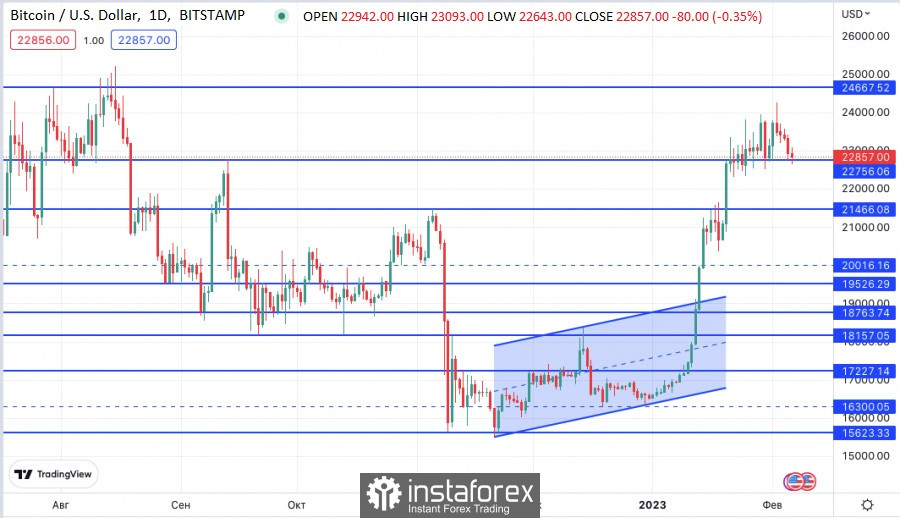Bitcoin, unable to climb above $24,000, has rolled back to the support level in the $22,700 area. It can now either recover to last week's highs or break through the current support and pull back to $21,500.
Let's see what events could be the catalysts for volatility this week.
Small players bought back Bitcoin on the decline
Rising prices above $20,000 in the second week of January led to market FOMO (fear of missing out), especially among small BTC holders.
Data provided by crypto analytics firm Santiment showed that there was a significant surge in BTC addresses holding 0.1 BTC or less after Jan. 13. Since then, 620,000 new BTC addresses have appeared, bringing the total to 39.8 million.
The rise in Bitcoin addresses holding small amounts indicates renewed investor optimism in 2023. It was very limited and slowed significantly after the FTX collapse in November 2022, but the rate of new address creation increased in 2023.
The recent surge is the highest since November 2022, when BTC fell to its cycle low of about $16,000. The price decline prompted small traders to buy up BTC at a lower price.
The current surge is due to a growing bullish sentiment in the market, where apart from Bitcoin, several altcoins have also recorded multi-month highs, while the overall cryptocurrency market is up more than 30%.
February may be less optimistic
After a busy first week in February, market analysts cautioned that this year's recovery in cryptocurrencies and stocks could be replaced by a bearish pullback this month. They attributed the potential coming downtrend to the scale of interest rate hikes by the Federal Reserve.
The price of the major cryptocurrency is still heavily influenced by macroeconomic conditions in the U.S. Initially, the price of BTC rose due to the Fed's decision to raise the benchmark interest rate by 25 basis points and Fed Chairman Jerome Powell's dovish comments.
However, Friday's U.S. jobs data triggered a pullback. According to the latest data from the U.S. Bureau of Labor Statistics, the U.S. economy saw a sensational gain of 517,000 new jobs last month. This was seen by the market as an indication that the Fed is likely to keep interest rates high for longer. Against this backdrop, the dollar index regained most of its January losses.
What Bitcoin traders to watch out for this week
This week's news backdrop is expected to be relatively quiet. The most important event could be on Tuesday, when Powell delivers another speech.
Investors will be listening to see if Powell supports the Fed's hawkish monetary policy with new statements after strong U.S. labor market data or repeats his dovish statements from the FOMC press conference.
The latter seems unlikely, however, as a persistently robust labor market will undoubtedly expand the central bank's future monetary policy discretion.
Presumably, the new deciding factor will be the release of U.S. inflation data on February 14. Whether Powell will be tempted to make new comments tomorrow remains to be seen.
The second half of the week will focus on the latest U.S. initial jobless claims data. In addition to the labor market report released Friday, this figure is considered the second most important for assessing the U.S. labor market.
If more US citizens file for unemployment benefits, Friday's report could be revised, and sentiment in the cryptocurrency market could return to bullish thanks to a further drop in DXY.
Finally, you could also pay attention to the University of Michigan's data on U.S. consumer confidence on Friday. If it turns out to be positive, it could also support risk appetite and the crypto market.
Institutional traders are in the minority
Finally, it is worth looking at the situation more globally by looking at a new JPMorgan Chase survey. It shows that 72% of institutional traders "have no plans to trade crypto," while 14% plan to trade cryptocurrencies within five years. Institutional traders also expect "recession risk" to have the biggest impact on markets in 2023.
The survey, conducted in January, provides "insight into predictions for the year ahead," the bank said in a statement. It surveyed 835 institutional traders in 60 global locations, 72% of traders surveyed "have no plans to trade crypto/digital coin," with 14% predicting they're not currently trading but plan to trade within 5 years. 8% are currently trading, and 6% are not currently, but plan to start within 1 year.
Furthermore, institutional traders predicted that cryptocurrencies and digital coins will "have the biggest increases in electronic trading volumes over the next year." In addition, "100% of responding traders predicted they will increase electronic trading activity," JPMorgan noted.
Institutional traders on recession and inflation
The survey also asked institutional traders about their economic outlook.
"Traders predict that 'recession risk' will have the biggest impact on markets in 2023, closely followed by 'inflation' and 'geopolitical conflict,'" JPMorgan explained. At the same time, 44% of traders predict inflation will decrease.
While most institutional traders surveyed by JPMorgan have no plans to invest in crypto, several other surveys show stronger institutional interest in this asset class.
A survey by asset management firm Devere Group found that 82% of millionaires asked their financial advisors about adding cryptocurrencies, including Bitcoin, to their portfolios.
A different survey by Nickel Digital Asset Management found that institutional investors expect "a strong year ahead for Bitcoin," with 65% agreeing that BTC could reach $100,000.
Last month, global investment bank Goldman Sachs ranked Bitcoin the best-performing asset this year.










